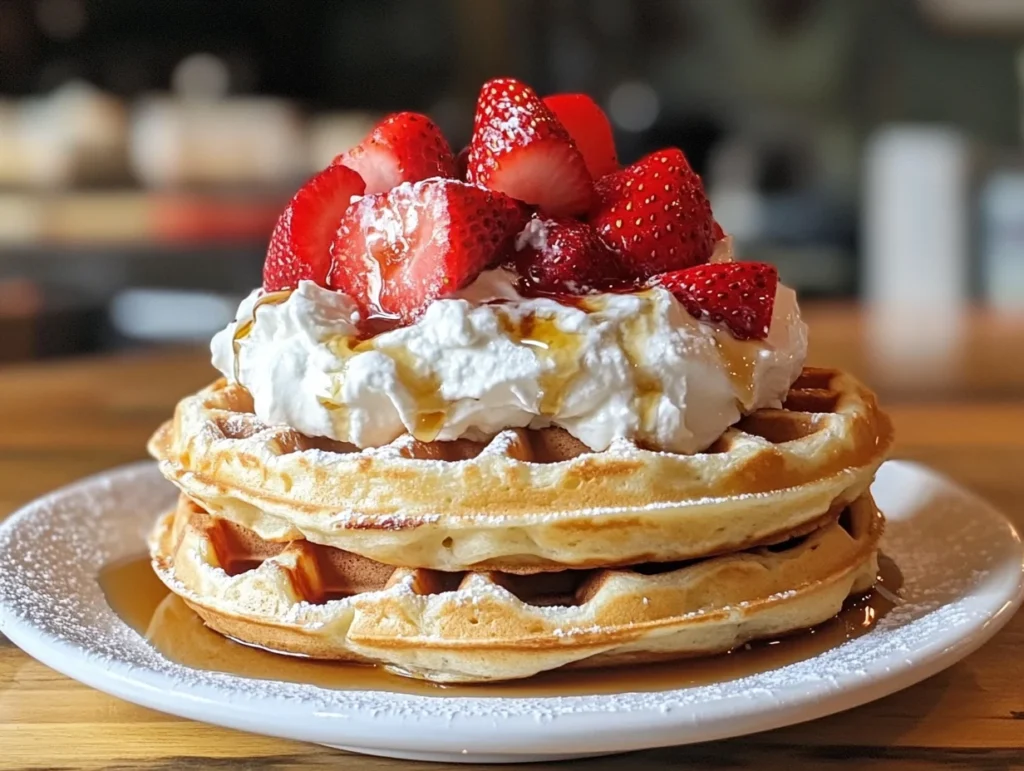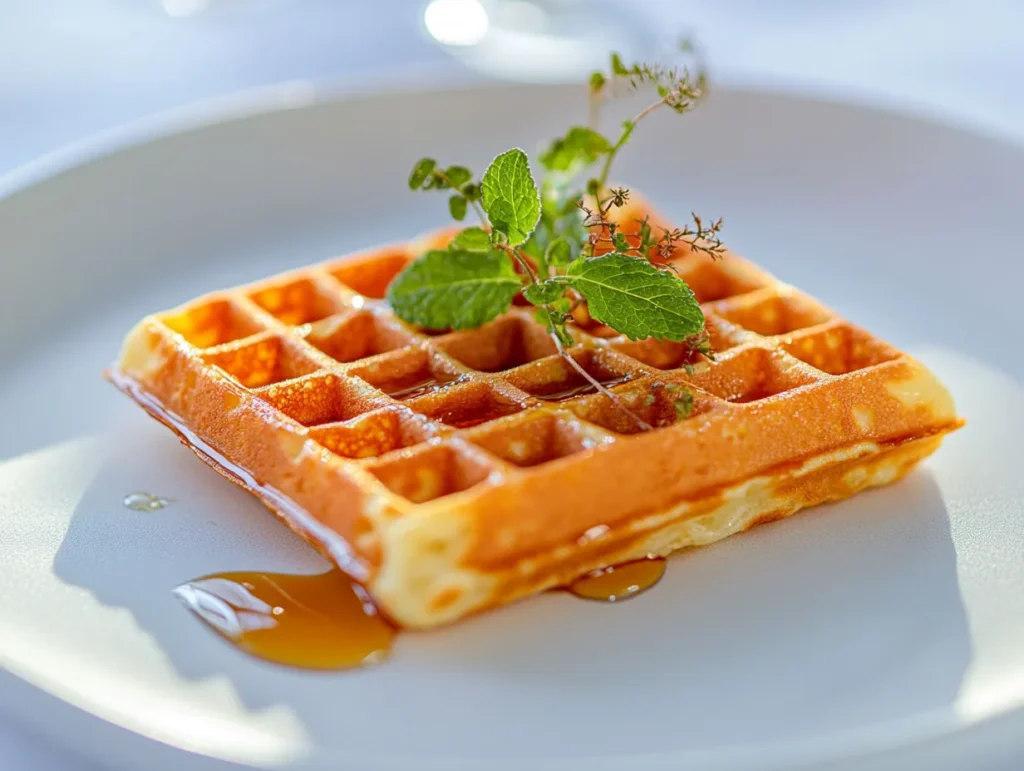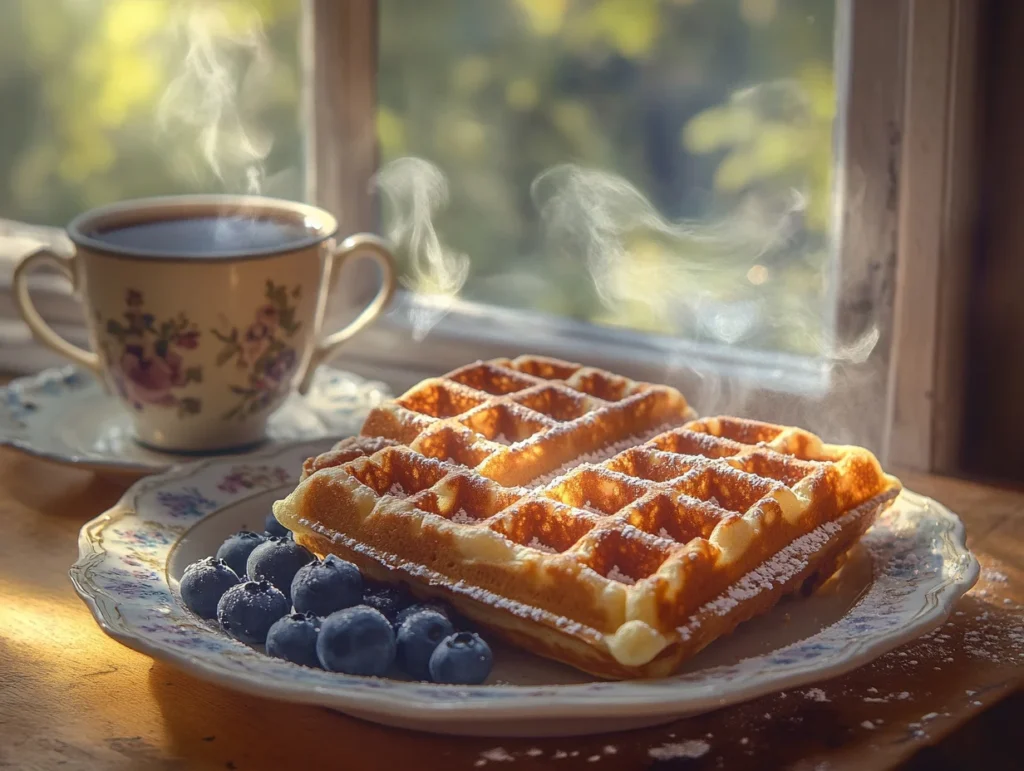1. Introduction
Belgian waffles are more than just a breakfast staple; they are a culinary delight that has captured the hearts (and stomachs) of food enthusiasts across the globe. Known for their deep pockets, light texture, and crispy exterior, these waffles have become synonymous with indulgence. Whether piled high with whipped cream and strawberries or drizzled with maple syrup, Belgian waffles offer a perfect balance of flavor and texture.

Alt Text: A stack of golden Belgian waffles topped with whipped cream, strawberries, and maple syrup on a wooden table.
In the United States, Belgian waffles have become a beloved treat not just for breakfast but also for brunch, dessert, and even as a street food. Their versatility has allowed them to transcend cultural and geographical boundaries, making them a universal symbol of comfort food. But what makes Belgian waffles so unique? And how did they achieve such widespread fame? Let’s dive into the fascinating story behind these iconic waffles.
2. History of Belgian Waffles
The history of Belgian waffles is as rich as the waffles themselves. Their origins trace back to medieval Belgium, where early versions of waffles were made from simple batter and cooked between two metal plates. These early waffles were not the sweet treats we know today but were often savory, served alongside hearty meals. The design of the plates often included intricate patterns, which would imprint decorative textures onto the waffles.
From Belgium to the World Stage
The modern Belgian waffle that we recognize today began to take shape in the 19th century. By this time, waffle recipes started incorporating leavening agents like yeast, which gave the waffles a light and airy texture. In Belgium, two distinct styles of waffles emerged: the Brussels waffle, known for its rectangular shape and light, crispy texture, and the Liège waffle, a denser, sweeter variety made with pearl sugar.
Belgian waffles gained international fame when Maurice Vermersch introduced them at the 1964 New York World’s Fair. Originally called “Brussels waffles,” they were renamed “Belgian waffles” to make them more appealing to the American audience. Vermersch’s waffles were served with whipped cream and strawberries, a combination that quickly became iconic. The world was hooked, and Belgian waffles became a sensation in the United States and beyond.
3. What Makes a Belgian Waffle Different?
When you think of waffles, the term Belgian waffle likely stands out for its distinct characteristics. But what truly sets them apart from regular waffles? The answer lies in a combination of their texture, size, and method of preparation.

Alt Text: A single golden Belgian waffle drizzled with honey and garnished with mint on a white plate.
Texture and Pockets
Belgian waffles are celebrated for their fluffy interior and crisp exterior. This unique texture results from the use of a lighter batter, often made with beaten egg whites or yeast as a leavening agent. The yeast allows the batter to rise, creating airy pockets within the waffle. These deep pockets are another signature feature of Belgian waffles, making them ideal for holding generous amounts of syrup, butter, whipped cream, or other toppings.
Larger and Thicker
Belgian waffles are generally larger and thicker than traditional waffles. Their size is a result of using specially designed waffle makers with deeper grids, which create their characteristic square or rectangular shape. This added thickness gives them a more substantial bite and allows for a more complex flavor profile, as the exterior crisps up while the interior remains soft and tender.
The Ingredients
The batter for Belgian waffles often includes key ingredients like yeast or baking powder, which contribute to their airy texture. Vanilla and a touch of sugar are commonly added to enhance the flavor, making them slightly sweeter than regular waffles. Unlike some traditional American waffles, Belgian waffles are less dense and more focused on lightness and crispiness.
4. Why Are They Called Belgian Waffles?
The term Belgian waffle may seem straightforward, but its history reveals an interesting journey. The name itself has become a global identifier for a particular style of waffle, but its roots lie in the country’s rich culinary heritage.
Historical Context
In Belgium, waffles have been a staple food for centuries, with different regions developing their unique versions. The Brussels waffle, for example, is known for its lightness and rectangular shape, while the Liège waffle is sweeter and denser, thanks to the inclusion of pearl sugar. When Maurice Vermersch brought the Brussels waffle to the United States in the 1960s, he initially called it the Brussels waffle. However, he soon realized that many Americans were unfamiliar with Brussels and decided to rename it the Belgian waffle, capitalizing on the country’s association with high-quality European cuisine.
The Global Impact
The name “Belgian waffle” stuck and quickly became synonymous with indulgence and luxury. Today, the term is used worldwide to describe waffles that meet specific criteria: light, fluffy interiors, deep pockets, and a crisp texture. Interestingly, not all “Belgian waffles” are authentically Belgian. In many parts of the world, the term refers more to the style of preparation than to any direct connection to Belgium. Nonetheless, the name has helped cement their place as a beloved treat on breakfast tables everywhere.
5. Traditional Belgian Waffle Recipe
Creating Belgian waffles at home is easier than you might think, and it all starts with a perfect batter. The traditional recipe focuses on simple ingredients, precise measurements, and a few key techniques to achieve their iconic fluffy texture and crispy exterior.
Ingredients
To make authentic Belgian waffles, you’ll need the following:
- 2 cups all-purpose flour
- 2 tablespoons granulated sugar
- 2 teaspoons baking powder (or 1 teaspoon yeast if opting for a yeast-based batter)
- 1/2 teaspoon salt
- 2 large eggs (separated into yolks and whites)
- 1 3/4 cups whole milk
- 1/3 cup unsalted butter (melted)
- 1 teaspoon vanilla extract
Step-by-Step Preparation
- Combine dry ingredients. In a large mixing bowl, whisk together the flour, sugar, baking powder, and salt. Set aside.
- Prepare the wet ingredients. In a separate bowl, whisk together the egg yolks, milk, melted butter, and vanilla extract until smooth.
- Mix the batter. Gradually pour the wet ingredients into the dry ingredients. Stir until just combined; avoid overmixing to maintain a light texture.
- Whip the egg whites. In a clean bowl, beat the egg whites until stiff peaks form. Gently fold the whipped egg whites into the batter. This step is crucial for creating an airy and fluffy waffle.
- Preheat the waffle iron. Heat your Belgian waffle maker according to the manufacturer’s instructions. Lightly grease the grids with cooking spray or melted butter.
- Cook the waffles. Pour an appropriate amount of batter onto the center of the waffle maker (usually about 1/2 to 3/4 cup). Close the lid and cook until the waffle is golden brown and crispy, typically 4-5 minutes.
- Serve immediately. Remove the waffle from the iron and serve hot with your favorite toppings.
Tips for Success
- Use room-temperature ingredients to ensure the batter blends smoothly.
- If using yeast, allow the batter to rest for 1-2 hours to develop flavor and rise.
- Avoid stacking cooked waffles; instead, keep them warm in a single layer in a low-temperature oven to maintain crispiness.
6. Variations of Belgian Waffles
While traditional Belgian waffles are a delight on their own, there are several variations that offer unique textures and flavors. Two popular styles stand out: Brussels waffles and Liège waffles.

Alt Text: Liège-style Belgian waffles with caramelized edges, served with blueberries and coffee.
Brussels Waffles
- Characteristics: These waffles are rectangular, light, and airy, with deep pockets that are perfect for holding toppings. Their batter typically includes yeast, which contributes to their delicate texture and slightly tangy flavor.
- Toppings: Common toppings include powdered sugar, fresh berries, whipped cream, and chocolate drizzle. They’re often served as a dessert or a sweet treat at fairs and festivals.
Liège Waffles
- Characteristics: Unlike Brussels waffles, Liège waffles are dense and chewy. The batter includes pearl sugar, which caramelizes during cooking, creating a sweet and slightly crunchy exterior.
- Toppings: Liège waffles are often enjoyed plain due to their inherent sweetness, but they can also be served with fruit, ice cream, or Nutella.
Regional Adaptations
Belgian waffles have inspired countless adaptations worldwide:
- Savory Belgian waffles: These include ingredients like cheese, herbs, and bacon, making them perfect for brunch or dinner.
- Vegan and gluten-free versions: Made with plant-based milk and gluten-free flour, these options cater to dietary preferences without sacrificing flavor.
- Dessert waffles: Chocolate-infused batter or waffles topped with ice cream and caramel sauce transform this breakfast classic into a decadent dessert.
Each variation brings a unique twist to the traditional recipe, ensuring there’s a Belgian waffle to suit every taste.
7. Cooking Belgian Waffles: Equipment and Techniques
The secret to perfect Belgian waffles lies not just in the batter but also in the tools and techniques used during the cooking process. Whether you’re a beginner or an experienced cook, the right equipment and methods will elevate your waffles to a professional level.
Choosing the Right Waffle Maker
The signature deep pockets of Belgian waffles require a specific type of waffle iron. Here’s what to consider when selecting your equipment:
- Belgian Waffle Maker: Designed with deeper grids, these irons create the iconic shape and texture of Belgian waffles.
- Electric vs. Stove-Top Models: Electric waffle makers are user-friendly and come with temperature controls, while stove-top models offer more versatility but require careful monitoring.
- Non-Stick Coating: A non-stick surface ensures easy removal of waffles and reduces the need for excessive greasing.
If you don’t own a Belgian waffle maker, you can use a regular waffle maker. However, the waffles will lack the deep pockets and fluffy texture that define Belgian waffles.
Temperature and Timing
Temperature plays a crucial role in achieving the perfect waffle. Preheating your waffle iron ensures even cooking and a crispy exterior. Set the iron to medium-high heat for a golden-brown finish. Cooking times vary depending on the model, but most Belgian waffles take 4-5 minutes per batch.
Tips for Flawless Results
- Avoid Overfilling the Iron: Pour just enough batter to cover the bottom grid without overflowing. Too much batter can lead to uneven cooking.
- Don’t Peek Too Early: Opening the waffle maker too soon can cause the batter to stick or tear.
- Clean Between Batches: Remove any leftover batter or crumbs to prevent sticking in subsequent waffles.
Mastering these techniques ensures consistently delicious waffles every time.
8. Serving Belgian Waffles
Once your Belgian waffles are perfectly cooked, it’s time to think about presentation and toppings. The beauty of Belgian waffles lies in their versatility, making them suitable for both sweet and savory combinations.
Traditional Toppings
Belgian waffles are often served with simple yet classic toppings, such as:
- Powdered Sugar: A light dusting of powdered sugar adds a subtle sweetness and enhances the presentation.
- Whipped Cream and Fresh Berries: Strawberries, blueberries, or raspberries complement the waffles’ flavor while adding a burst of color.
- Maple Syrup or Honey: These natural sweeteners soak into the deep pockets, providing a rich, satisfying taste.
Modern Twists
For a creative spin, consider these unique topping ideas:
- Savory Options: Try pairing waffles with fried chicken, bacon, or scrambled eggs for a hearty meal.
- Dessert Delights: Top with a scoop of vanilla ice cream, hot fudge, and crushed nuts for an indulgent dessert.
- Healthy Alternatives: Use Greek yogurt, granola, and fresh fruit for a nutritious breakfast option.
Pairing Suggestions
Belgian waffles pair well with a variety of beverages and side dishes:
- Hot Drinks: Coffee, espresso, or hot chocolate are classic choices for breakfast or brunch.
- Cold Beverages: Freshly squeezed orange juice, smoothies, or milkshakes complement the sweetness of the waffles.
- Side Dishes: Add a side of crispy bacon, sausage, or fresh fruit salad to complete your meal.
The endless topping and pairing options make Belgian waffles a versatile dish that can be tailored to any occasion.
9. Belgian Waffles in Popular Culture
Belgian waffles have transcended their culinary roots to become cultural icons, often appearing in media, events, and even memes. Their versatility and visual appeal have made them a staple in the breakfast lexicon and a symbol of indulgence.
Appearances in Media
Belgian waffles frequently feature in movies, TV shows, and advertisements, often depicted as the ultimate comfort food. From sitcom breakfast scenes to romantic comedy brunches, they are portrayed as a treat that brings people together. Their eye-catching toppings and decadent presentation make them a visual feast that resonates with audiences.
One notable pop culture moment includes their appearance at the Stranger Things “Eggo” waffle craze, which indirectly brought more attention to waffles in general, including Belgian-style variations. In addition, they’ve been highlighted in cooking competitions and reality shows, where chefs push the boundaries of creativity with their waffle-based recipes.
Symbol of Decadence and Celebration
Belgian waffles have become synonymous with celebrations, from brunch parties to food festivals. Their deep pockets and fluffy texture symbolize luxury and indulgence, making them a popular choice for birthdays, anniversaries, and even weddings. In some U.S. cities, “waffle trucks” serve them as gourmet street food, further cementing their role as a cultural favorite.
Social Media and the Waffle Aesthetic
Platforms like Instagram and Pinterest have elevated Belgian waffles to new heights, with users sharing artfully arranged plates featuring vibrant toppings and unique presentations. The hashtag #BelgianWaffles trends frequently, showcasing how this dish continues to capture the imagination of food lovers worldwide.
10. Health Considerations
While Belgian waffles are undeniably delicious, they are often viewed as a treat rather than an everyday meal. Understanding their nutritional profile and exploring healthier options can help balance indulgence with well-being.
Nutritional Information
A classic Belgian waffle made with traditional ingredients typically contains:
- Calories: Around 300-400 per waffle (without toppings)
- Carbohydrates: Approximately 40-50 grams
- Fat: 10-15 grams
- Protein: 6-8 grams
The nutritional content increases significantly when sugary toppings, whipped cream, or syrups are added. While these waffles provide energy, they are also high in refined carbohydrates and fats, which should be consumed in moderation.
Healthier Alternatives
For those seeking lighter options, there are ways to make Belgian waffles more nutritious:
- Whole Grain Flour: Substitute all-purpose flour with whole wheat or oat flour for added fiber.
- Low-Sugar Batter: Reduce the sugar content in the batter or use natural sweeteners like honey or maple syrup.
- Plant-Based Ingredients: Use almond milk, coconut oil, or flaxseed eggs for a vegan-friendly version.
- Savory Variations: Opt for savory toppings like avocado, spinach, or smoked salmon to create a balanced meal.
Moderation is Key
Belgian waffles can be part of a balanced diet when enjoyed in moderation. Pairing them with nutrient-rich toppings, like fresh fruit or Greek yogurt, can help offset their high calorie content. Additionally, making smaller waffles or sharing a serving can reduce overall consumption while still satisfying your cravings.
11. Frequently Asked Questions (FAQs)
This section answers some of the most common queries about Belgian waffles, providing helpful insights for both beginners and enthusiasts.
What makes a Belgian waffle different?
Belgian waffles stand out for their light, airy texture and deep pockets. These characteristics result from a lighter batter, often made with yeast or beaten egg whites. Their larger size and crispy exterior further distinguish them from traditional waffles.
Why is it called Belgian waffles?
The name “Belgian waffles” originated when Maurice Vermersch introduced the Brussels-style waffle to the U.S. at the 1964 New York World’s Fair. Recognizing that Americans were more familiar with the term “Belgian” than “Brussels,” he renamed the dish for broader appeal. Today, the term is used globally to describe this specific style of waffle.
Can you cook Belgian waffles in a regular waffle maker?
Yes, you can cook Belgian waffles in a regular waffle maker, but the results may differ. Regular waffle makers lack the deep grids required for the signature pockets, resulting in a thinner and less airy waffle. For authentic results, a Belgian waffle maker is recommended.
Why are Belgian waffles so crispy?
Belgian waffles achieve their crispiness through a combination of factors: the use of yeast or baking powder, proper preheating of the waffle iron, and the batter’s high-fat content. These elements create a golden-brown crust while keeping the interior light and fluffy.
12. Conclusion
Belgian waffles are more than just a breakfast item—they are a celebration of texture, flavor, and culinary creativity. Their deep pockets and light, crisp texture make them a canvas for endless topping combinations, from simple powdered sugar to elaborate dessert creations.
Whether you’re savoring a traditional Brussels waffle with fresh strawberries or indulging in a caramelized Liège waffle, the joy of Belgian waffles lies in their versatility and universal appeal. By understanding their history, mastering their preparation, and exploring creative variations, you can bring this iconic dish into your own kitchen.
So, why not whip up a batch of Belgian waffles today? Whether it’s for breakfast, brunch, or dessert, these waffles are sure to delight your taste buds and bring a touch of indulgence to any occasion.
